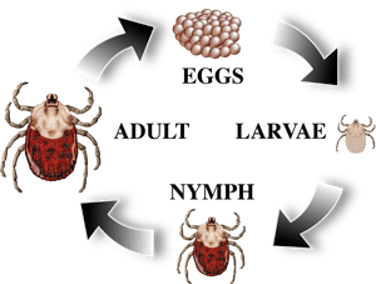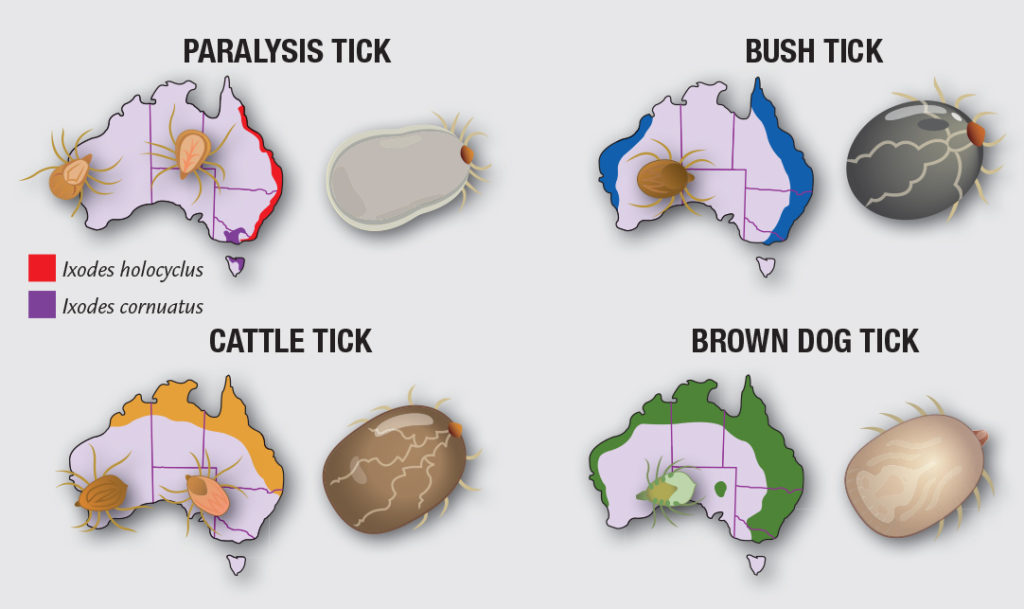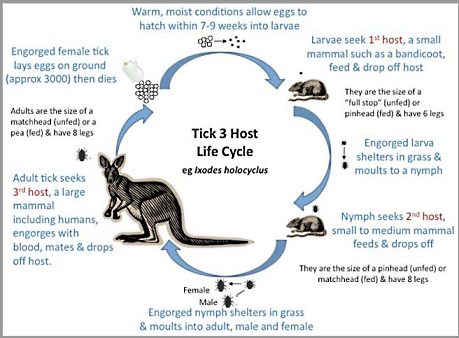tick life cycle australia
The cattle tick life cycle is an average of 21 days. The egg larvae around 1mm and light brown in colour when not full of blood nymph around 2mm and pale brown and the adults 45mm in length without blood.

Life Cycle Of A Multi Host Argasid Tick Example Is Ornithodoros Download Scientific Diagram
Tick paralysis is most likely to be seen in children.

. Tick Life Cycle Australia. Inside or out ticks love a warm environment to lay their eggs. The parasitic stage of the life cycle involves 3 phases.
They may be small but theyre prolific. These stages are egg larvae or seed tick nymph and adult. It can take up to three years for a tick to complete its life cycle but many die in process seeking a host.
Larvae or seed ticks hatch from eggs and swarm up grass blades where they may survive for up to 6 months before finding a suitable host. A tick life cycle generally involves four stages. Flattened from top to bottom overall oval seed-shaped body.
After a two-year life cycle a female tick can lay thousands of eggs. Female cattle ticks feed on blood for 7 to 12 days. Each life stage can be present throughout the year although for the Paralysis tick adults are more abundant in the spring and the early summer months larvae in mid to late-summer and nymphs during winter.
On average it will take approximately a year to complete but it is very much dependent on climatic conditions. Cattle ticks undergo a moult on the host between the larval nymph and adult phases. After hatching the larvae climb onto nearby vegetation and look for their first hosts.
Egg larva nymph and adult. Life Cycle of Ticks. Ticks go through four life stages.
Ticks are not able to lay eggs directly on a host they must first detach. Life cycle of cattle ticks There are four stages in the life cycle of the cattle tick. The female paralysis tick lays up to 3000 eggs.
During the moult the tick sheds the previous skin or shell in order to emerge into the next life stage ie. Gravid pregnant female ticks lay batches of up. The Paralysis Tick needs to feed on blood to develop through its lifecycle from the larvae stage to a nymph and to an adult.
The eggs hatch and six-legged larvae emerge from the eggs. Normally this would be a bandicoot or possum which become immune to the poison. Larvae nymph and adult.
They are not very mobile but rely on passing animals to both feed on and transport them. Eggs are not dangerous and appear as a brownish-red translucent color. The Australian climatic and environmental conditions provide suitable conditions for many ticks.
1 The Egg Stage 1 After the adult female tick has acquired a proper blood meal she mates with the adult male tick leaves the host and searches for a suitable spot to lay her eggs. The life cycle of a tick is completed after four stages namely egg larva nymph and adult it requires more than a year to complete a full life cycle. There are 4 distinct stages of the life cycle of the Australian Paralysis Tick egg larva nymph adult.
Its important to be familiar with this life cycle to get rid of ticks from your lawn and landscape and prevent tick bites. The initial symptoms of tick paralysis may include unsteady gait increased weakness of the limbs. After hatching from the eggs ticks must eat blood at each stage in order to move on to the next one.
The Australian Paralysis Tick Ixodes holocyclus is found in Eastern Australia and is a parasite to native mammals livestock pets and even people. Ixodes scapularis the black-legged deer tick which is the primary vector for Lyme disease has a four-stage life cycle and a lifespan of about two years. Cattle ticks undergo a moult on the host between the larval nymph and adult phases.
After hatching from the eggs ticks must eat blood at every stage to survive. Under laboratory conditions female ticks have been kept alive for more than two years. Egg six-legged larva eight-legged nymph and adult.
Home Tick Advice The Paralysis Tick Life Cycle. The majority of hard ticks require three different hosts to complete their development. Ticks that require this many hosts can take up to 3 years to complete their full life cycle and most will die because they dont find a host for their next feeding.
As soon as theyve engorged the requisite quantity of blood the larvae drop to the bottom moult and switch into nymphs. When they do attach themselves to a host they feed for about a week shed their skins moult and turn into nymphs. Bothriocroton auruginans is a tick with an unknown life-cycle but its larvae and nymphs may attack domestic dogs without developing any illness.
Life cycle facts and figures. Ticks are known to inject toxins that cause local irritation or mild irritation however most tick bites cause little or no symptoms. The First Stage egg The adult female tick first fulfills a proper blood meal then the process of mating occurs between an adult male and adult female tick.
By the 19 th day after attachment as larvae the females start to mature once they reach 4-5mm long they engorge overnight and drop to the ground early the next morning. The cattle tick life cycle is an average of 21 days. However they can lay eggs just about anywhere else and they do.
Larvae moult into nymphs and nymphs moult into adults. Most ticks go through four life stages. Generally adult female hard ticks breed while on the host animal and then drop to the ground to lay eggs.
During this development ticks go through four stages of life. Four Life Stages. There are four stages in the life cycle of a tick.
Ticks are parasites that feed on the animal and human blood. At least 17 species of. The Paralysis Tick needs to feed on blood to develop through its lifecycle from the larvae stage to a nymph and to an adult.
Ticks will reproduce sexually and typically find mates by feeding on a host. It can take up to 3 years to complete a full lifecycle and most will die because they cant find a host for their next feeding. Stages in the Life Cycle of Ticks.
Female adult ticks lay up to 3000 eggs in litter of which x. Now let us look at their life cycle to get a better understanding. The total minimum life cycle is 45 months 135 days and the maximum 14 months 437 days.
Ornate kangaroo tick Amblyomma triguttatum All female ticks need to take a blood meal before producing eggs. This means that tick larvae and nymphs as well as full-grown adult ticks need to bite a host such as a human or a wild animal and suck its blood in order to survive. The cattle tick life cycle is an average of 21 days.
Australia is known to be endemic for 70 of the known 896 tick species. Ticks occur in humid moist bushy areas. The life cycle takes approximately 1 year to complete minimum 135-437 days Eggs.
Ticks have four stages of their life cycleeggs larvae nymphs and adult ticksand every stage except the eggs feeds on blood. Larvae have 6 legs while nymphs and adults have 8 like the rest of their arachnid relatives.

Mittagong Veterinary Hospital Great Tails And What S New Blog

Ticks And Prevention Lyme Disease Association Of Australia

Hang On A Tick Are Ticks Really The Vectors For Australian Trypanosomes Trends In Parasitology
Tick Life Cycles And Life Stages

Tick Season Warning Why Are Ticks A Big Problem In Australia Worlderz Com

Life Cycle Of Ixodes Holocyclus Paralysis Tick In Relation To Season Download Scientific Diagram

The Lifecycle Of The Three Host Tick Ixodes Holocyclus 5 Download Scientific Diagram

1 Typical Three Host Life Cycle Of A Female Ixodid Hard Tick Download Scientific Diagram

Ticks And Tick Paralysis Vet N Pet Help

Figure 6 From Ticks Of Australia The Species That Infest Domestic Animals And Humans Semantic Scholar

An Overview Of Tick Paralysis Symptoms Treatment And Prevention

Pdf Ticks Of Australia The Species That Infest Domestic Animals And Humans
Tick Life Cycles And Life Stages
Tick Life Cycles And Life Stages
Nymph Ticks The Top 7 Facts You Need To Know Tick Safe And The Mozzie Team

Paralysis Ticks Three Things You Need To Know To Save Your Pet S Life

